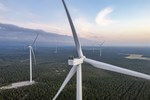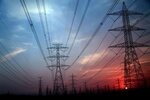05/08/2004
Facts about the European Commission EWEA/EC DG TREN Report
- Penetration levels in electricity production have reached 20% in Denmark and about 5% in both Germany and Spain. The north German state of Schleswig-Holstein has 1,800 MW of installed wind capacity, enough to meet 30% of the region's total electricity demand, while in Navarra (Spain) 50% of consumption is met by wind power.
- Even small changes in wind speed can produce large changes in the economic performance of a wind farm. For instance, a doubling of average wind speed increases the energy content of the wind by a factor of 8. Understanding the resource is the single most important step in establishing a wind farm.
- Commercial wind turbines began in earnest in the 1980s and in the last 20 years turbine capacity has increased by a factor of 100. In the same period wind power generation costs have declined by some 80%.
- A modern power generating wind turbine is designed to operate continuously, unattended and with low maintenance for more than 20 years, or some 120,000 hours of operation. By way of comparison, a car engine has a design lifetime of 4,000 to 6,000 hours.
- A wind farm can be monitored remotely, with a mobile team of roughly two personnel for every 20-30 turbines. Maintenance is usually carried out every six months. Typical maintenance time for a modern wind turbine is 40 hours per year
- At maximum, it takes a wind turbine 3-4 months to recover the amount of energy that goes into the production, operation and scrapping of the wind turbine at the end of its 20-year lifetime. A wind turbine will therefore save between 63-78 times the energy input over a 20 year lifetime.
- Current costs of producing on-shore wind power, depending on the wind speed, range from 4 - 9 euro-cent/KWh.
- Power production costs continue to decrease. With a doubling of total installed capacity, the cost of production per kWh will fall by 9%-17%. Assuming that this doubling takes place within five years, wind power production costs will drop to 3.9-5.2 euro-cent/KWh, or 3.1-4.4 euro-cent/KWh at high wind speed coastal areas.
- The external (environmental) costs to society of electricity production from wind power are estimated at less than 0.26 euro-cent/kWh whilst those for coal-fired generation range from 2 to 15 euro-cent/kWh.
- Wind energy installed in Europe today is avoiding external costs of euro 1.8 billion, that would rise to euro 25 billion/year by 2020.
- In Denmark, employment in the wind industry has increased from 2,900 in 1991 to 21,000 in 2002, faster than any other manufacturing sector.
- The number of people employed in the European industry has increased to over 72,000, compared to 25,000 in 1998. Following the EWEA Wind Force 12 scenario, employment in Europe could reach almost 200,000 by 2020, and in excess of 200,000 jobs in the rest of the world.
- In 2000, some 15 million tons of CO2 emissions - the main greenhouse gas contributing to climate change - were avoided across 28 European countries through wind energy generation.
- Under a conventional scenario, the world wind energy market would reach some 80,000 MW by 2007 and 161,000 MW by 2012. In the advanced scenario, the world market would reach 106,000 MW by 2007 and 311,000 MW by 2012.
- Even small changes in wind speed can produce large changes in the economic performance of a wind farm. For instance, a doubling of average wind speed increases the energy content of the wind by a factor of 8. Understanding the resource is the single most important step in establishing a wind farm.
- Commercial wind turbines began in earnest in the 1980s and in the last 20 years turbine capacity has increased by a factor of 100. In the same period wind power generation costs have declined by some 80%.
- A modern power generating wind turbine is designed to operate continuously, unattended and with low maintenance for more than 20 years, or some 120,000 hours of operation. By way of comparison, a car engine has a design lifetime of 4,000 to 6,000 hours.
- A wind farm can be monitored remotely, with a mobile team of roughly two personnel for every 20-30 turbines. Maintenance is usually carried out every six months. Typical maintenance time for a modern wind turbine is 40 hours per year
- At maximum, it takes a wind turbine 3-4 months to recover the amount of energy that goes into the production, operation and scrapping of the wind turbine at the end of its 20-year lifetime. A wind turbine will therefore save between 63-78 times the energy input over a 20 year lifetime.
- Current costs of producing on-shore wind power, depending on the wind speed, range from 4 - 9 euro-cent/KWh.
- Power production costs continue to decrease. With a doubling of total installed capacity, the cost of production per kWh will fall by 9%-17%. Assuming that this doubling takes place within five years, wind power production costs will drop to 3.9-5.2 euro-cent/KWh, or 3.1-4.4 euro-cent/KWh at high wind speed coastal areas.
- The external (environmental) costs to society of electricity production from wind power are estimated at less than 0.26 euro-cent/kWh whilst those for coal-fired generation range from 2 to 15 euro-cent/kWh.
- Wind energy installed in Europe today is avoiding external costs of euro 1.8 billion, that would rise to euro 25 billion/year by 2020.
- In Denmark, employment in the wind industry has increased from 2,900 in 1991 to 21,000 in 2002, faster than any other manufacturing sector.
- The number of people employed in the European industry has increased to over 72,000, compared to 25,000 in 1998. Following the EWEA Wind Force 12 scenario, employment in Europe could reach almost 200,000 by 2020, and in excess of 200,000 jobs in the rest of the world.
- In 2000, some 15 million tons of CO2 emissions - the main greenhouse gas contributing to climate change - were avoided across 28 European countries through wind energy generation.
- Under a conventional scenario, the world wind energy market would reach some 80,000 MW by 2007 and 161,000 MW by 2012. In the advanced scenario, the world market would reach 106,000 MW by 2007 and 311,000 MW by 2012.
- Source:
- EWEA
- Author:
- Trevor Sievert, Online Editorial Journalist
- Email:
- press@windfair.net
- Keywords:
- EWEA, European Commision, wind report, wind energy


























